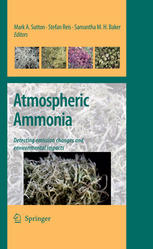

Most ebook files are in PDF format, so you can easily read them using various software such as Foxit Reader or directly on the Google Chrome browser.
Some ebook files are released by publishers in other formats such as .awz, .mobi, .epub, .fb2, etc. You may need to install specific software to read these formats on mobile/PC, such as Calibre.
Please read the tutorial at this link: https://ebookbell.com/faq
We offer FREE conversion to the popular formats you request; however, this may take some time. Therefore, right after payment, please email us, and we will try to provide the service as quickly as possible.
For some exceptional file formats or broken links (if any), please refrain from opening any disputes. Instead, email us first, and we will try to assist within a maximum of 6 hours.
EbookBell Team

0.0
0 reviewsAtmospheric ammonia is increasingly being recognized as a pollutant of key environmental concern. Ammonia contributes to several environmental problems, including direct toxic effects on vegetation, atmospheric nitrogen deposition, leading to the eutrophication and acidification of sensitive ecosystem, and to the formation of secondary particulate matter in the atmosphere, with effects on human health, atmospheric visibility and global radiative balance. Ammonia emissions are increasing rapidly in many parts of the world, so that these environmental concerns are expected to grow in future. In Europe, efforts are currently being made to reduce ammonia emissions, alongside reductions in other air pollutants, notably sulphur dioxide and nitrogen oxides. However, reducing ammonia emissions has proved uncertain and challenging, with only modest regional reductions achieved to date. As the emissions of sulphur dioxide and nitrogen oxides are reduced, ammonia is therefore increasingly dominating the air pollution climate of Europe and the consequent environmental impacts.
It was in this context that the leading international experts met in Edinburgh in December 2006 under the auspices of the UN-ECE Convention on Long Range Transboundary Air Pollution to review the current state of the science of ammonia in the atmosphere. Specifically, the international workshop was a joint effort between several bodies of the Convention: the Ammonia Expert Group, the Working Group on Effects and the Task Force on Measurement and Modelling, together with the COST 729 and the NitroEurope Integrated Project. This book reports the underpinning information in the form of several major reviews, combined with supporting chapters on recent research results, to provide an up-to-date scientific synthesis in relation to four key themes:
Each of these themes is of fundamental to the quantification of ammonia impacts in the environment and the assessment of possible abatement measures. The reviews highlight how the critical threshold for ammonia concentrations – the "critical level" – has been overestimated in the past, and the book explains the new estimates. Monitoring of atmospheric concentrations and deposition is the only independent way to verify the success of emission abatement policies. The analysis shows how it has been a major challenge to verify the reported reductions in emissions, but that several new datasets now support expected trends in emission reduction, even though total emissions may still be underestimated. Atmospheric models are central to the assessment at both regional and landscape scales. The dynamics within ‘ammonia hotspots’ are particularly important to understand both the fate of ammonia export from source regions and to assess the local environmental impacts. Similarly, modeling at regional scales forms the basis for transboundary assessment of ammonia emissions and deposition. At both scales, the present assessment shows that quantification of ammonia dry deposition remains a key uncertainty. Cross-cutting analyses in the review addressed the reliability of ammonia emissions data and abatement efficiencies, as well as the agricultural and environmental policy context, considering how scientific understanding can help address the challenges to reduce the adverse effects of ammonia in the environment.
This book will be valuable to all those interested in the behaviour of ammonia in the environment, as it explains the current state of knowledge, reports new critical level values, and describes the main scientific uncertainties.